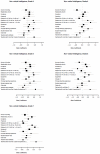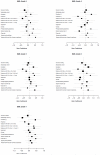School effects on non-verbal intelligence and nutritional status in rural Zambia
- PMID: 27175053
- PMCID: PMC4860740
- DOI: 10.1016/j.lindif.2015.04.004
School effects on non-verbal intelligence and nutritional status in rural Zambia
Abstract
This study uses hierarchical linear modeling (HLM) to examine the school factors (i.e., related to school organization and teacher and student body) associated with non-verbal intelligence (NI) and nutritional status (i.e., body mass index; BMI) of 4204 3rd to 7th graders in rural areas of Southern Province, Zambia. Results showed that 23.5% and 7.7% of the NI and BMI variance, respectively, were conditioned by differences between schools. The set of 14 school factors accounted for 58.8% and 75.9% of the between-school differences in NI and BMI, respectively. Grade-specific HLM yielded higher between-school variation of NI (41%) and BMI (14.6%) for students in grade 3 compared to grades 4 to 7. School factors showed a differential pattern of associations with NI and BMI across grades. The distance to a health post and teacher's teaching experience were the strongest predictors of NI (particularly in grades 4, 6 and 7); the presence of a preschool was linked to lower BMI in grades 4 to 6. Implications for improving access and quality of education in rural Zambia are discussed.
Keywords: Body Mass Index—BMI; Zambia; multilevel analysis; non-verbal intelligence; school context; sub-Saharan Africa.
Figures


Similar articles
-
Physical growth and nonverbal intelligence: associations in Zambia.J Pediatr. 2014 Nov;165(5):1017-23.e1. doi: 10.1016/j.jpeds.2014.07.058. Epub 2014 Sep 10. J Pediatr. 2014. PMID: 25217196 Free PMC article.
-
School physical activity environment related to student obesity and activity: a national study of schools and students.J Adolesc Health. 2009 Sep;45(3 Suppl):S71-81. doi: 10.1016/j.jadohealth.2009.04.008. Epub 2009 Jun 21. J Adolesc Health. 2009. PMID: 19699440
-
The academic penalty for gaining weight: a longitudinal, change-in-change analysis of BMI and perceived academic ability in middle school students.Int J Obes (Lond). 2015 Sep;39(9):1408-13. doi: 10.1038/ijo.2015.88. Epub 2015 May 18. Int J Obes (Lond). 2015. PMID: 25982793
-
Nutrition and physical activity related school environment/policy factors and child obesity in China: a nationally representative study of 8573 students in 110 middle schools.Pediatr Obes. 2017 Dec;12(6):485-493. doi: 10.1111/ijpo.12169. Epub 2016 Jul 7. Pediatr Obes. 2017. PMID: 27384757
-
Body mass index trend as a new parameter for evaluating children's nutritional status.Public Health. 2019 Aug;173:138-145. doi: 10.1016/j.puhe.2019.04.014. Epub 2019 Jul 9. Public Health. 2019. PMID: 31299482
Cited by
-
Cognitive and academic performance of rural Zambian youth exposed to HIV.AIDS Care. 2023 Mar;35(3):453-460. doi: 10.1080/09540121.2022.2050175. Epub 2022 May 4. AIDS Care. 2023. PMID: 35509240 Free PMC article.
-
Identifying learning patterns of children at risk for Specific Reading Disability.Dev Sci. 2016 May;19(3):402-18. doi: 10.1111/desc.12313. Epub 2015 Jun 2. Dev Sci. 2016. PMID: 26037654 Free PMC article.
References
-
- Archibald S. Narrowing in on educational resources that do affect student achievement. Peabody Journal of Education. 2006;81(4):23–42.
-
- Attanasio OP, Maro VD, Vera-Hernández M. Community nurseries and the nutritional status of poor children. Evidence from Colombia. The Economic Journal. 2013;123(571):1025–1058.
-
- Baker DP, Goesling B, Letendre GK. Socioeconomic status, school quality, and national economic development: a cross-national analysis of the "Heyneman-Loxley Effect" on mathematics and science achievement. Comparative Education Review. 2002;46(5):291–312.
-
- Bernell SL, Mijanovich T, Weitzman BC. Does the racial composition of the school environment influence children's body mass index? Journal of Adolescent Health. 2009;45(1):40–46. - PubMed
-
- Borland MV, Howsen RM. An examination of the effect of elementary school size on student academic achievement. 2003
Grants and funding
LinkOut - more resources
Full Text Sources
Other Literature Sources
Miscellaneous
